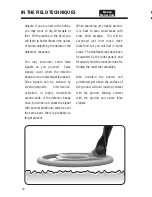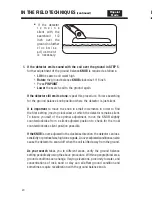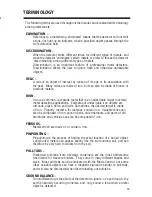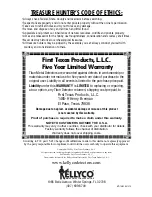
12
13
AUDIO TARGET IDENTIFICATION
While the
LCD
(
Liquid Crystal Display
) is very accurate in identifying buried
objects, the user in the field does not always maintain the display screen in his
field of vision. Therefore, we have incorporated an audio feedback mechanism
to alert the user to the nature of buried objects. This audio feedback system first
alerts the user to the presence and classification of objects, whose nature and
location can be confirmed using the
LCD
display.
The detector can sound four different tones, depending on the object detected.
Audio Target Identification (ATI) classifies metals into four categories.
BASS TONE
Nails, Iron Objects,
& Smallest Gold Objects
LOW TONE
Pull Tabs, Nickels,
& Smaller Gold
MEDIUM TONE
Zinc Pennies (Post 1982),
Larger Gold Objects, Many
screw caps
HIGH TONE
Copper, Silver & Brass
Copper Pennies (Pre 1982)
BASS TONE
Ferrous objects, such as iron and steel, will
induce a bass tone.
The smallest gold objects can also induce a
bass tone.
LOW TONE
Pull-Tabs, nickels & smaller gold
MEDIUM TONE
Newer pennies (post-1982), larger gold
objects, zinc, small brass objects, and most
bottle screw caps will induce medium tones.
Many recent vintage foreign currencies will
induce medium tones.
HIGH TONE
Silver and copper coins, larger brass objects,
older pennies (pre-1982), and highly oxidized
metals will induce high tones. Quarters,
dimes and other precious coins fall into this
category.
Motion
Modes Only
TARGET AND DEPTH DISPLAY
Motion
Modes Only
READING THE DISPLAY
The Liquid Crystal Display (
LCD
) shows the
PROBABLE
identification of the targeted
metal, as well as the
PROBABLE
depth of
the target, in inches.
The detector
will register a repeating,
unchanging target identification when
a buried target has been located and
identified. If, upon repeated passes over
the same spot, the target identification
reads inconsistently, the target is probably
a trash item, or oxidized metal. With
practice, you will learn to unearth only the
repeatable signals.
The segment identifications
are highly
accurate, when detecting the objects
described on the label. However, if you
register in a given category for an unknown
buried object, you could be detecting
a metallic object other than the object
described on the label, but with the same
metallic signature. Also, the greater the
distance between the target and the coil, the
less accurate the target identification.
GOLD TARGETS:
Gold objects will
register on the left side of the
LCD
scale.
Gold will register depending upon its
size. The smaller the gold object, the
further to the left it will register.
Gold flakes
will register under Iron-1
Small gold items
will register under Iron
or 5¢/PT.
Medium-sized gold items
will register
under PT or S-cap.
Large gold items
will register under S-
cap or Zinc.
SILVER TARGETS:
Silver objects will
register to the right of the scale, under
25¢, 50¢, or $1, depending on the size
of the object. The larger the object, the
farther to the right it will register.
IRON:
Ferrous objects will register on
the far-left side of the target identification
scale. 1, 2, or 3 indicates the relative
size of iron objects. Small nails, for
instance, will usually illuminate the
Iron-1 arrow whereas large structural
ferrous objects will usually illuminate
the Iron-3 arrow.
Objects in this category could be worthless
scrap, or a more valuable iron relic.
5c/PT:
Nickels and most newer pull-
tabs(those that stay attached to the
can) will register here.
PT(pull-tabs):
Pull-tabs from older
beverage cans will register here. Few
newer pull-tabs will also register here.
Many gold rings will also register here.
S-CAP:
Older screw caps from glass
bottles will register here. Large gold rings,
like a class ring, could also register here.
Some non-U.S. coins of recent vintage
will also register here.
ZINC:
Newer pennies (post-1982) will
register here. Many non-U.S. coins of
recent vintage will also register here.
Cu10¢:
Dimes and pre-1982 pennies will
register here. Older, pre-1982, pennies are
composed of copper, which has a metallic
signature similar to a dime. Most copper
coins will register here.
Caution:
The target indications are
visual references. Many other types of
metal can fall under any one of these
categories. While the
Titan 3000 XD
will
eliminate or indicate the presence of most
common trash items, it is impossible to
accurately classify
ALL
buried objects.
DEPTH INDICATOR:
The Depth Indicator is accurate for
coin-sized objects. It indicates the
depth of the target, in inches. Large
and irregularly-shaped objects will yield
less reliable depth readings
When passing over
an object, the
depth indicator will light up and stay
illuminated until another object is
scanned. Repeated indication at the
same depth level indicates an accurate
target detector. If the depth indication
varies with each sweep, try sweeping
at different angles; there may be more
than one target present. With practice,
you will learn the difference between
accurate readings, multiple targets, and
highly erratic readings which evidence
trash or irregularly shaped objects.
Содержание 3000XD
Страница 1: ...Owner s Manual 3 08 ays ful...
Страница 4: ...ASSEMBLY continued I...










































